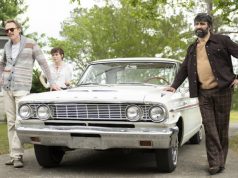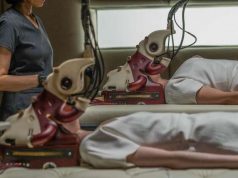Above all else, “In America” is clearly an act of catharsis for its writer/director, Jim Sheridan, who uses the story of Irish immigrants coming to New York in the 1980s to tell his own story. His previous films, “My Left Foot” (1989), “In the Name of the Father” (1993) and “The Boxer” (1997), had personal elements to them, but “In America” trumps them all in that respect, and Sheridan’s heart and soul are evident in scene after evocative scene.
The film is set approximately in 1982 (“E.T.” is playing in theaters), though the many anachronisms — the “Aida” marquee in Times Square, to name only one — suggest a certain timelessness. (In Entertainment Weekly, Sheridan said he lacked the budget to give his sets a 1980s makeover, and that he liked the ethereal “when are we?” element anyway.) Johnny Sullivan (Paddy Considine) has moved his wife Sarah (Samantha Morton) and daughters Christy and Ariel (real-life sisters Sarah and Emma Bolger) to New York, hoping The City holds a better life for them. Johnny wants to be an actor, and seems to have some talent for it, though the pressures of supporting a family demand that he get a job as a cab driver in the meantime. Sarah works at a nearby ice cream parlor, and the girls experience a good old-fashioned unbearably hot New York summer with the wide-eyed delight and optimism of youth.
The family has suffered, though. The youngest Sullivan child, Frankie, died a year ago, and no one has fully recovered from the loss. Eleven-year-old Christy, who has a camcorder (another anachronism) and who is our eyes into the film, believes Frankie can grant her three wishes from heaven. She uses the wishes carefully, and tells us of her decisions with melancholic thoughtfulness.
In their slummy apartment building, there is a screaming, reclusive artist named Mateo (Djimon Hounsou) whom the girls befriend and who proves to be useful later on. These young actresses, without much professional experience under their belts, are fantastic at conveying the blithe naivete of the young. They never seem to view New York as a dangerous place, even though they live in a bad part of town and have screaming reclusive neighbors. Life is an adventure, meant to be experienced to the fullest. When sad things occur, like the death of their baby brother, one deals with them however one must and one moves on. It’s the grownups who tend to forget that.
I like the feel of the film, the way it puts us into the various seasons of New York realistically, without the gloss normally used by movies set in the Big Apple. Through the girls’ eyes, we see the magic of childhood, but with the addition of the parents’ point of view, we see it in the context of the real world. It’s a film full of rich, warm humor, honest emotion and gentle, gradual healing.
B+ (1 hr., 43 min.; )





